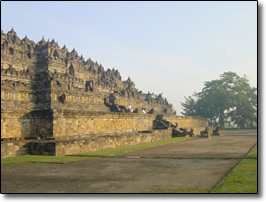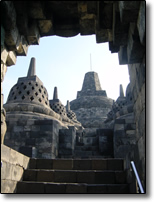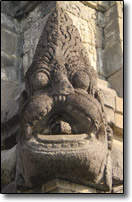
Borobudur
Still a bit groggy from our night of climbing, we hitched a ride down the mountain and then took a series of busses to get to Borobudur. It was Sunday, so rather than proceed immediately to the temple, no doubt crowded, we opted to see the smaller ones in the vicinity, leaving Borobudur for sunrise the next day. In the half-light of early morning we walked down the street to the main entrance, through the gates and hawker stalls, and up the incline to the massive temple. In a broad valley of green rice fields and swaying palms, surrounded by mountains and volcanoes, Borobudur, an 8th-century Buddhist masterpiece, crowns a small hill. The temple, actually a giant mandala in stone, is designed to stimulate the intellect rather than the eye. From a distance it looks unimpressive. Only on closer inspection does the wonderful symmetry and meaning of the site become clear. Sculpted out of dark volcanic rock, rising like a wide pyramid, are nine levels of “existence”, from the world of desire through the world of forms to the formless. Niches with statues line the walls and passageways.
 |
 |
Carved on the inside of the lower levels are bas-reliefs depicting scenes from Buddhist scripture and mythology. On the highest three levels the walls fall away, revealing fantastic views of the surrounding terrain, crowned by a smoking Mt. Merapi in the distance. Here, “formlessness” is represented by hollow, bell-shaped lattices of volcanic stone with statues inside, arranged in concentric circles and topped with a giant, solid stupa. We arrived at the upper level just as the sun was rising behind Merapi. As the mist hovering in the valley slowly dissolved, the air cleared. Free to wander the different levels and admire the carved panels, we were quickly exhausted by the scale of the temple and the merciless tropical sun. To follow the whole path from the bottom to the top, passing all of the panels, would require walking over two miles! We made our way to the museum, where black-and-white pictures showed the restoration work done on the temple in the 1970s and 80s as well as the destruction caused by a terrorist bomb in 1985.
 |
 |
